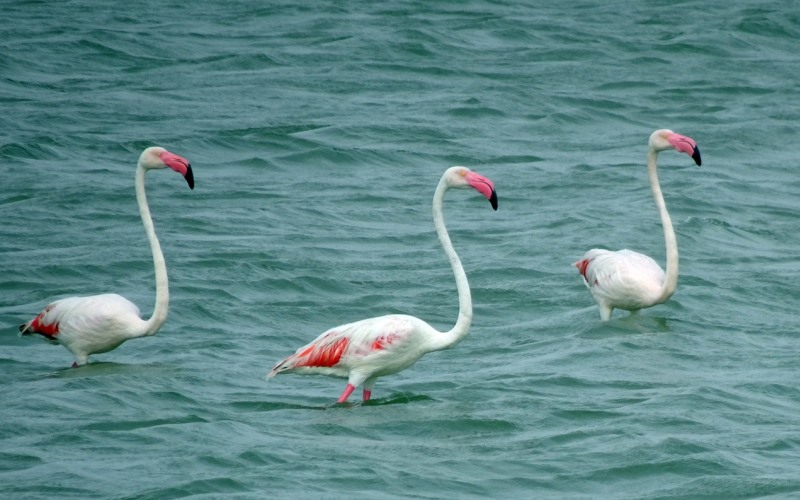Mumbai must pay attention to its pink winged friends

Every year, at the onset of winters, a breath-taking spectacle along the coastal wetlands of Mumbai and Navi Mumbai turns it pink. With the urban landscape in its background, it is as if the coastal wetlands have been painted with a mosaic of attractive and elegant pink. This happens due to the migration, in large numbers, of greater flamingos (Phoenicopterus roseus) and lesser flamingos (Phoenicopterus minor) to Mumbai. The migration pattern of the flamingos seems to be governed by monsoon and they usually arrive in Mumbai from Gujarat, Rajasthan, and some from south-central Asia and beyond.
Flamingos are known for their attractive pink feathers, long legs and distinctively curved bills. 6 species of flamingos known worldwide, of these the greater flamingo is commonly observed in Mumbai. The lesser flamingo can also be spotted in Mumbai. Greater flamingo is categorized as least concern while the lesser flamingo is categorized as near threatened by the International Union for Conservation of Nature’ Red List of Threatened Species. It is easy to differentiate between the two species.
The lesser flamingos are around three feet tall and have rose-pinkish colours. The greater flamingos are about five feet tall and have whitish-pink colours. Lesser flamingos are shorter in stature and they compensate this with their rich and vibrant colours. The smaller ones have deep pink feathers, nearly red legs, and a black bill, while the larger ones have light pink legs and a few pink streaks on their feathers. The flamingos have earned their name because at sunset they resemble flames.
Flamingos are highly sociable and usually form large colonies in shallow wetlands where they feed on algae, crustaceans, and small invertebrates. Their pink colouration is a result of their diet which is rich in carotenoid pigments. The birds stalk over the mud flats with their beaks skimming the ground as they take in the dirty water to be processed by their special filtration systems, into food. Lesser flamingos mostly eat cyanobacteria or blue-green algae, and greater flamingos also eat mussels, shrimp and other types of food. The mud flats of Thane Creek are covered in enormous amounts of these cyanobacteria, much more than any other Creek around.
Although these flamingos began migrating to Mumbai in large numbers only since the 1990s, they are now not just visitors but vital components of Mumbai’s ecosystem. They are especially found along the 26 km Thane Creek in the East of Mumbai. With rapid urbanisation of Mumbai since the 1970s, Thane Creek witnessed an increase in the discharge of large volume of untreated sewage from the city. This nurtured the growth of algae which are the main food of these flamingos. This early urbanisation transformed the area into a feeding ground for the flamingos and made the Creek their alternate home.
In Mumbai, the mudflats of Sewri, Bhigwan Bird Sanctuary, Thane Creek and the coastal regions of Navi Mumbai district are the prominent places to watch the flamingos. Flamingos have become part of Mumbai’s coastal landscape but efforts need to be made to connect them with the average Mumbaikar. Efforts have already been made in the form of Run for Flamingo events but there is a clear need to do more. Flamingos have begun facing new threats along with ones already faced by them. Indiscriminate urbanization towards the coast, pollution, loss of habitat and related human disturbance pose significant risks to the flamingos.
Rapid industrialization and encroachment on wetlands in recent years have led to habitat degradation. Pollution from industrial effluents further compounds the problem, contaminating the water and directly affecting the food source of the flamingos. In addition, while the mangroves support the local biodiversity and are beneficial for the fish population, they grow on the mudflats and decrease the available safe area for the flamingos to forage.
Mangroves have many other uses such as acting as barrier against the surge of storm and sea level rise which makes them important in the area. The Government of Maharashtra also banned their removal in 2018. But to keep the mudflats intact for the flamingos, the Thane Creek Flamingo Sanctuary needs to innovate ways such that both the mangroves and flamingo habitats can be protected and kept safe.
The recently inaugurated Mumbai Trans Harbour Link (MTHL) spans 22 km and connects Sewri and Uran going along the flamingo habitat. The new airport in Navi Mumbai also has considerable potential to impact the migratory habitat of flamingos. Flamingo habitat management is crucial to ensure not just the conservation of these enchanting pink birds, but also flight safety after the airport becomes fully operational.
A draft tourism initiative in Navi Mumbai has most recently put a question mark on the sustainability of flamingo habitat. Threats like these requires all residents of Mumbai to recognize the importance of flamingos and join efforts for the conservation of their habitats. Flamingos are iconic birds serving as symbol of ecological harmony in the rapidly urbanising Mumbai city. Mumbai needs to make them an integral part of its socio-cultural fabric by celebrating their arrival and giving them a warm send-off year after year.
Image by B. Sarangi




Absolutely mesmerized by them, nature’s wonders never fail to inspire.
Reading about flamingos flocking to Mumbai is like witnessing nature’s vibrant artwork come alive! It’s incredible how these graceful birds transform Mumbai’s salt pans into a breathtaking spectacle each year. Loving Mumbai’s seasonal visitors! ✨
I agree with you! These pink winged species make our city colourful during their migration season. It is a must watch sight.
Thanks for this, I live close to them but seldom get time to visit the Creek to see them. I will definitely try to visit them soon!!!!
I also desire to visit the place, but my college schedule is not on my side .
However, I plan to visit the place once before I graduate!